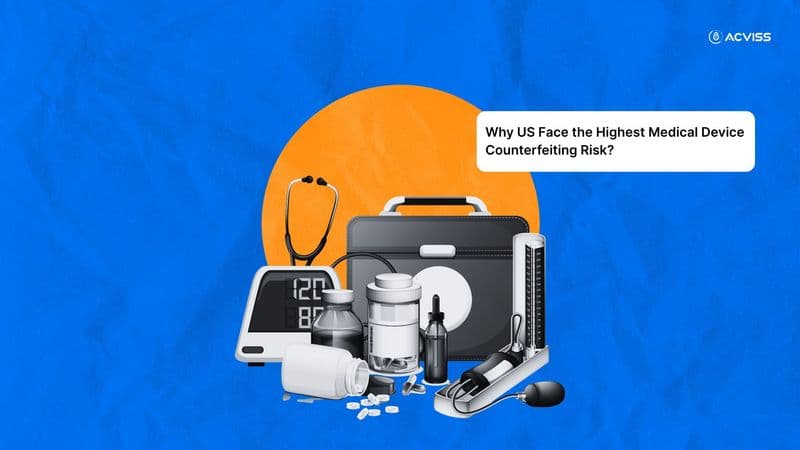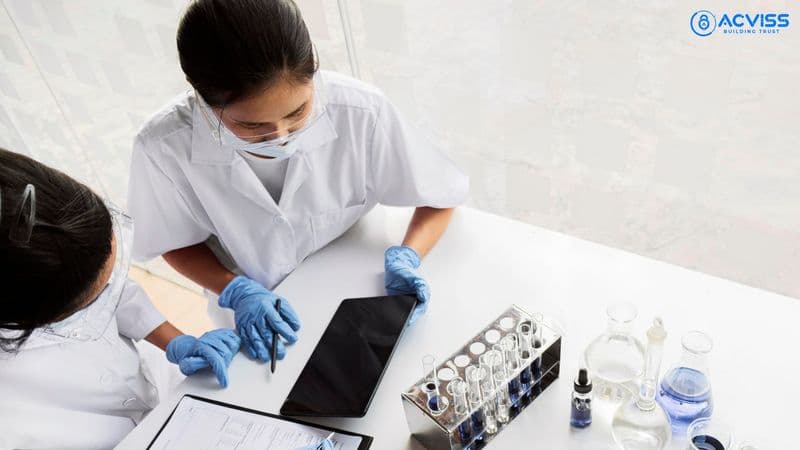Why These Five US Regions Face the Highest Medical Device Counterfeiting Risk

Medical device counterfeiting in the United States has evolved into a complex, multi-layered challenge. It is no longer limited to unscrupulous manufacturers attempting to replicate high-value devices. Today, counterfeiters exploit the gaps within sprawling distributor networks, fragmented hospital procurement systems, and the speed of digital commerce. As a result, certain regions in the US experience disproportionately higher exposure. A closer look reveals why states such as Texas, Florida, California, New Jersey and New York consistently surface in risk analyses, and what brands must do to stay ahead.
Medical devices worth billions move through the US healthcare system every year. According to the US Department of Commerce, the national medical device market exceeded 180 billion dollars in 2023 and is projected to reach 230 billion dollars by 2028. High demand, vast product diversity and pressing supply chain pressures create the perfect environment for product authentication failures, product verification gaps and counterfeit infiltration. When even a single device is compromised, patient safety, physician trust and brand integrity are instantly at stake.
The Rise of Medical Device Counterfeiting in the US
Medical devices worth billions move through the US healthcare system every year. The United States remains the largest medical device market in the world, with medical goods exports exceeding $103 billion in 2023. High demand, vast product diversity and pressing supply chain pressures create the perfect environment for product authentication failures, product verification gaps and counterfeit infiltration. When even a single device is compromised, patient safety, physician trust and brand integrity are instantly at stake.
Medical device counterfeiting has expanded rapidly over the past decade. It is no longer limited to fake orthopaedic implants or imitation surgical instruments. Today, counterfeiters target everything from diagnostic test kits and blood glucose monitors to ventilator parts and wearable devices.
The US, as one of the world’s largest healthcare markets, remains a prime target. Counterfeiters thrive on three systemic weaknesses:
1. Complex distribution networks
Major healthcare hubs operate through intricate chains involving manufacturers, authorised distributors, sub-distributors, procurement offices, hospital chains and independent medical practices. Any lack of transparency increases the risk of unauthorised intermediaries slipping into the system.
2. Procurement pressure
US hospitals face constant cost constraints. Counterfeiters exploit price sensitivity by offering low-cost alternatives that look legitimate but compromise safety.
3. Rapid growth of e-commerce
Online marketplaces and B2B trading platforms have made it easier for counterfeit sellers to reach healthcare buyers without stringent checks, making brand verification and brand authentication more urgent.
These are national issues, yet five regions stand out consistently because the risk compounds with local market behaviour, industry concentration and import exposure.
Why The United States Faces an Elevated Counterfeiting Risk
Texas, Florida, California, New Jersey and New York represent some of the US’s largest healthcare and logistics ecosystems. Their scale, international connectivity and distribution complexity explain why counterfeiters focus heavily on these markets.
1. High volumes of device movement
All five states handle enormous inflows of medical devices, either through ports, airports, large hospital chains or pharma-heavy industrial corridors. California alone processes over 40 per cent of all cargo entering the US. New Jersey is home to some of the largest pharmaceutical and medical distributors. Texas and Florida have major international trade routes that connect with Latin America. New York’s healthcare system is among the most extensive in the country.
2. Dense healthcare networks
Within these states, thousands of hospitals, clinics, surgery centres and home-care providers operate with decentralised procurement systems. The more touchpoints within the ecosystem, the more opportunities for infiltration.
3. Heavy distributor–hospital chain complexity
The distributor–hospital chain relationship in these regions can involve multiple intermediaries. A single device may pass through several warehouses before reaching a hospital. Each additional layer creates both operational opacity and vulnerability. For counterfeiters, these multi-layered pathways serve as convenient entry points.
4. Diverse and price-sensitive markets
States like Florida and Texas have strong secondary healthcare markets, including urgent care chains, private clinics and long-term care facilities. Under financial pressure, these entities may unknowingly purchase from grey-market vendors, making product authentication essential.
High import exposure
Ports across California, New Jersey, Texas and Florida receive large shipments from international manufacturers. Criminal groups exploit these inflows by mixing illegitimate products with legitimate consignments, especially in high-demand categories.
These factors explain why these five regions consistently surface in regional counterfeiting analysis reports. But understanding the underlying mechanics helps brands develop stronger defences.
How Counterfeit Devices Exploit the Weak Links
Counterfeit infiltration does not happen in one dramatic breach. It occurs through a series of small, often unmonitored steps. The following mechanisms are common across high-risk US states:
Grey-market distributors
Unregistered distributors posing as brokers often target smaller hospitals and clinics. They offer genuine-looking devices at discounted rates. Without a robust product verification system, many buyers cannot detect subtle differences.
Warehouse diversions
When supply chain management is stretched, unauthorised substitutions can occur within warehouses. A counterfeit batch can easily enter legitimate inventory when monitoring systems are weak.
Used and refurbished devices are re-labelled as new
Fraudsters often obtain used devices from recycling channels, clean them, repackage them and sell them as new. Older devices sold as newer models create major safety risks.
Fake sterilisation and compliance documents
Counterfeiters are now forging FDA clearance papers, serial numbers and barcodes. Without secure brand authentication layers, these documents look legitimate to procurement teams.
These tactics are difficult to identify without advanced anti-counterfeiting technologies and strong brand protection strategies.
Why Product Authentication and Verification Must Be a Priority

The medical device market is deeply dependent on trust. Every component, every implant and every instrument affects patient safety. When a counterfeit device enters a hospital:
- The patient's health is endangered
- Brand reputation suffers
- Regulatory non-compliance escalates
- Recall and liability costs rise
A robust product authentication framework enables hospitals, distributors and regulators to verify every device’s origin, movement and legitimacy.
The role of product verification
Product verification is not just about checking a serial number. It involves real-time validation of manufacturing data, shipment history, distribution pathways and tamper evidence. For medical devices, this becomes a critical component of product safety and IP protection.
Track and trace as a backbone
Track and trace systems connect every stage of the device’s journey. When implemented properly, they create complete product traceability that blocks unauthorised intermediaries. It also supports EUDR-aligned guidelines for transparent documentation.
Brand protection as a strategic advantage
Hospitals overwhelmingly prefer brands that demonstrate strong security. In a competitive market, brand protection is no longer optional. It influences customer satisfaction, trust and long-term loyalty.
Strengthening Device Security with Non-Cloneable Technology

Counterfeiters grow more sophisticated every year. Basic barcodes and QR codes can be copied. Packaging can be duplicated. Even official-looking documents can be forged. This is why brands need product authentication solutions that cannot be tampered with.
Acviss Certify introduces non-cloneable technology that makes every product label uniquely verifiable. Each code is impossible to replicate and links the device to a secure digital certificate that hospitals, distributors and regulators can check instantly. For regions with high distributor–hospital chain complexity, such as California or Florida, a system like this closes the gaps counterfeiters rely on.
Combining Certify with end-to-end track and trace systems enables brands to gain durable protection against warehouse diversions, grey-market manipulation and mislabelled batches. More importantly, it gives hospitals a simple yet reliable mechanism to check authenticity at the point of use.
Preparing for the Next Phase of Medical Device Security
Addressing the risk in hotspots like Texas, New York, or New Jersey requires a multi-layered approach. Manufacturers must reinforce their supply chain management processes, strengthen product traceability and deploy authentication methods that cannot be duplicated. Hospitals must adopt stricter verification protocols and invest in technologies that enhance brand verification and brand authentication. Regulators must continue tightening oversight, especially around online marketplaces and cross-border shipments.
The future of medical device security depends on collaboration. As counterfeiters evolve, the healthcare industry must evolve faster. Brands that take proactive steps today not only reduce risk but also build stronger trust with healthcare providers and end users.
Conclusion
Medical device counterfeiting is a national concern, yet the risks intensify in regions where trade density, distributor complexity and healthcare scale intersect. Texas, Florida, California, New Jersey and New York remain key hotspots because counterfeiters exploit the very systems that make these states industry leaders.
Strengthening authentication, embracing product verification, and investing in advanced brand protection solutions are essential steps. Technologies like non-cloneable security labels, combined with track and trace infrastructure, give brands the control and visibility they need to operate securely in high-risk markets.
Interested to learn more? Get in touch with us.
